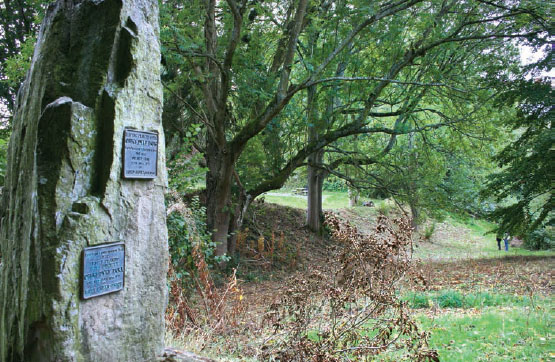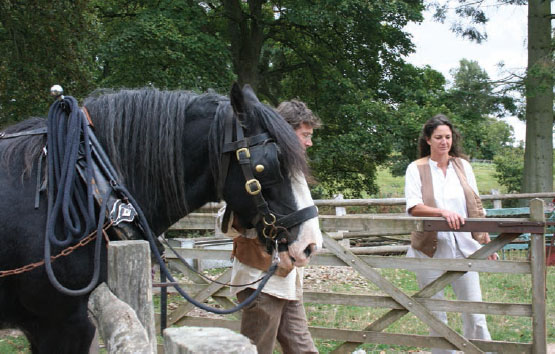
For serious Anglophiles who want to see the classic Britain of yore and a gentler way of life, it is hard to beat the rural, agrarian landscapes of the border counties known as the Marches, from the Wye Valley north to Cheshire.
Far from the big city lights, life is still paced more moderately and lived close to the land. Here is a bright, diverse itinerary, with modest drive times and a great many places to stop off along the way.
Let’s Head for Hereford
Some two hours west of the M25 and London Heathrow, begin this journey with an overnight in Chepstow, Monmouth, or Ross-on-Wye. From whichever interesting border town you choose, the first destination is Hereford, ancient cathedral city and county town of rural Herefordshire (population 55,000). The dramatic must-see is 12th-century Hereford Cathedral. Apart from its wonderful Cathedral Green, Norman arches, and clerestory, the cathedral is home to famed 14th-century Mappa Mundi—“Map of the World,” as it was perceived then—and the largest medieval chained library in Europe. Check out as well Hereford’s great pedestrianized shopping precinct, colorful covered market, and the black-and-white Old House, now a museum to Hereford’s life in the 1600s.
It’s Unspoiled Countryside to Ludlow
It’s an easy scenic drive today through the rolling agrarian countryside of Herefordshire. Loop via the A438 or A4110 to Knighton to stand on the ancient border between England and Wales at the Offa’s Dyke Centre. The earthwork was built in the 8th century by the Saxon king of Mercia, Offa, extending 150 miles to mark the boundary between England and Wales. Learn the whole story of the wall’s history and walk a short stretch of the dyke along the 176-mile-long Offa’s Dyke Trail.
You might pause as well to climb the ramparts of once-powerful Wigmore Castle, or scan the 1461 battlefield at Mortimer’s Cross, a turning point for the Yorkists in the Wars of the Roses. Our destination is the market town of Ludlow, just over the Shropshire border. This classically 12th-century town was laid out in the shadow of Ludlow Castle. There are a variety of options, but the classic stay in the 17th-century coaching inn, The Feathers Hotel, among the best-known hotels in England.

Walk a piece of Offa’s Dyke Trail along 8th-century earthworks at the Offa’s Dyke Centre.
Getting a Taste of Ludlow
It’s one of the prettiest market towns in the country, so do stop and smell the roses for a day in Ludlow—and the breads, cheeses, chocolate, sausages, and chutneys. Ludlow is the quintessential foodie town, and the entire town takes it seriously. From bakeries and butcher shops to delis and cafes, Michelin-star dining to gastropub grub, every snack, meal, and the stolen bite seems to be at the top of its game. Visit the Ludlow Food Centre to marvel at the stalls of regional comestibles. Most days as well, there is a market of one sort or another in the Market Place at the forecourt of Ludlow Castle.
The market and the town, of course, exist because of the castle. Once the seat of the powerful Council of the Marches, Ludlow Castle’s location on the Welsh border guaranteed its strategic and political importance for centuries. Prince Arthur died here in 1502, making the future King Henry VIII heir to the throne.
A Shropshire Idyll
Follow the A49 north today toward the Shropshire county town of Shrewsbury. This is the countryside of poet A.E. Housman’s A Shropshire Lad. Get a glimpse of the Shropshire he would have known at Acton Scott Working Farm. See what life was like on a large, self-sufficient Victorian farmstead—animals and agrarian practice, domestic life and craft skills.
The county town of Shropshire (population 72,000), Shrewsbury’s largely intact medieval street plan has preserved an astonishing range of England’s architectural history, with more than 650 listed buildings. Visit once powerful and still majestic Shrewsbury Abbey (proud of its association with Brother Cadfael), St. Chad’s Church, and Quarry Park beside the River Severn, the Shropshire Regimental Museum at Shrewsbury Castle, or the birthplace of Charles Darwin. Shrewsbury is a great town for shopping, too. Lodgings abound, but for a real old-town Shrewsbury experience, plan a stay at the historic Lion Hotel or the Prince Rupert.

At Acton Scott Working Farm, draft horses work the land and carry the loads as in Victorian times.
Shrewsbury and the Neighborhood
There certainly may be enough to attract you to spend the day in Shrewsbury. Or explore a piece or two of the neighborhood. It’s only a few miles along the Severn to Ironbridge Gorge, the birthplace of the Industrial Revolution. The World Heritage site contains 10 museums, including Blists Hill Victorian Town and, yes, the world’s first iron bridge. Or visit Wroxeter Roman City, once Viroconium, and the third-largest town in Roman Britain. Or the pretty Shropshire town of Much Wenlock and the superbly manicured ruins of romantic Wenlock Priory.
Via the Welsh Mountains to Cheshire
From Shrewsbury, take the A5 north this morning. The route turns west into Wales above Oswestry. Our destination visit is the marvelous Welsh mountain market town of Llangollen, site of the famous annual Llangollen International Musical Eisteddfod. Besides the pretty town center, replete with shops, sundry cafes and pubs, take a narrow-boat ride on the Llangollen Canal, or a steam train excursion through the Dee Valley on the Llangollen Railroad. Just a mile or so up the valley, visit the dramatic ruins of Valle Crucis Abbey (painted several times by J. M. W. Turner) and the 8th-century Pillar of Eliseg. Perhaps pay a visit to unusual Plas Newydd, home to the strangely celebrated “Ladies of Llangollen.”
Read more
Backtrack a few miles to the A483, then through Wrexham a dozen miles to Chester.
If you’ve not seen it from the canal, don’t miss stopping to gawk at Pontcysyllte Aqueduct. Completed in 1805, it is the longest navigable aqueduct in Britain and highest in the world.
Cheshire’s cathedral city, Chester is a destination visit in its own right. Plan a day or two to explore. Founded as a Roman fort in A.D. 79, Chester is one of the most complete walled cities in Britain. Walk the walls and Chester’s famous black-and-white Rows of arcaded shops, visit red sandstone Chester Cathedral, the Grosvenor Museum, and sundry Roman ruins.
Beyond Chester by Road or Rail
By rail or road, Chester is a crossroads. Turn in your rental car and take the train back to London. Or travel by either train or car to nearby Merseyside and the maritime (and Beatles) history of Liverpool. Further north lies the Lake District. Or turn west on the A55 across the north coast of Wales to Conwy and Snowdonia. Keep going on the train line to the Isle of Anglesey and Holyhead, a terminus for ferries to Ireland. The road always leads on!





Comments